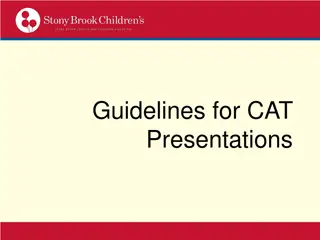
Caesarean Section: Definition, History, Epidemiology, Types, Risks, and Procedures
"Explore the comprehensive guide to Caesarean section, covering its definition, historical origins, epidemiological data, different types, indications, risks, pre-operative considerations, surgical procedures, and post-operative care. Learn about the fascinating history, classification, and anatomy of the anterior abdominal wall related to C-sections. Discover insights into Tolac, Vbac, and more aspects of this important surgical intervention in obstetrics."
Download Presentation

Please find below an Image/Link to download the presentation.
The content on the website is provided AS IS for your information and personal use only. It may not be sold, licensed, or shared on other websites without obtaining consent from the author. If you encounter any issues during the download, it is possible that the publisher has removed the file from their server.
You are allowed to download the files provided on this website for personal or commercial use, subject to the condition that they are used lawfully. All files are the property of their respective owners.
The content on the website is provided AS IS for your information and personal use only. It may not be sold, licensed, or shared on other websites without obtaining consent from the author.
E N D
Presentation Transcript
Presentation Outline Definition History Epidemiology Types Indications Risks/ complications Pre-Op Operation Anatomy of Anterior Abdominal Wall Post Op TOLAC VBAC
Definition A caesarean section is a surgical procedure in which incisions are made through a woman s abdomen (laparotomy) and uterus (hysterotomy) to deliver one or more babies.
History Three theories about the origin of the name caesarean; Roman legal code called Lex Caesarea- law stated that the baby should be cut out of the mother s womb in the case that she dies before giving birth. 1st century AD story by Pliny the Elder, who claimed that an ancestor of Caesar was delivered in this way
Derived from the Latin verb caedere, to cut The first recorded survivor 1500 in Switzerland: Jakob Nufer, a pig gelder, performed on his wife after a prolonged labour. March 5th, 2000, In s Ram rez performed a caesarean section on herself and survived, as did her son.
Epidemiology UK 25% and 30% of deliveries U.S. rate in 2011 was approximately 33% Maternal mortality (<0.1%) Case fatality rate for all caesarean sections is five times that for vaginal delivery
Classification Elective o usually booked days or weeks ahead of time and are conducted during daytime hours Emergency o All other caesarean sections, irrespective of whether the woman was in labour or not.
Abdominal Incisions 1. Pfannenstiel/ Transverse curvilinear incision 2 fingerbreadths above the symphysis pubis extending from and to points lateral to the lateral margins of the abdominal rectus muscle
2. A transverse suprapubic incision with no curve advantages of improved cosmetic results, decreased analgesic requirements and superior wound strength.
3. A vertical skin incision lower midline incision made from the lower border of the umbilicus to the symphysis pubis, and may be extended caudally toward the xiphisternum.
Indications : o extreme maternal obesity o surgical intervention for other intra-abdominal pathologies o where access to the uterine fundus may be required (classical caesarean section).
Advantages greater ease of access to the pelvic and intra-abdominal organs May be enlarged more easily Disadvantage higher incidence of wound dehiscence
Uterine Incisions Low Transverse Uterine Incision Most commonly used Location: the non-contractile portion of the uterus The bladder must be dissected off the lower uterine segment. Risk of uterine rupture in subsequent labor : 0.5%.
Advantages Advantages Disadvantages Disadvantages Safe subsequent TOLAC The fetus(es) must be in longitudinal lie Lower risk of bleeding and adhesions the lower segment must be developed Ease of repair potential extension into the uterine vessels laterally and into the cervix and vagina inferiorly
Classical/ Sanger Less commonly performed Location: made in the contractile fundus of the uterus Repeat cesarean should be scheduled before labor onset.
Indications Emergency lower uterine segment fibroids lower segment covered with dense adhesions placenta previa, abruption transverse lie with the back down fetal abnormality (e.g. conjoined twins) carcinoma of the cervix Postmortem CS Cord prolapse
Advantages Advantages Disadvantages Disadvantages Easy to perform Higher risk of uterine rupture 5% No bladder dissection is needed Higher risk of bleeding and adhesions Fetal orientation doesn t affect delivery TOLAC is unsafe Lower segment varicosities or myomas can be bypassed Uterine closure is more difficult
Low vertical The vertical incision begins in the non-contractile lower segment but usually extends into the contractile upper segment
Uterine rupture in future pregnancies (1) Low transverse scar (one): less than 1% (2) Low vertical scar: 0.5% to 6.5% (3) Classic scar: as high as 10%
Indications The four major indications accounting for greater than 70% of operations are: Previous caesarean section. Malpresentation (mainly breech). Failure to progress in labour (CPD). Suspected fetal compromise in labour. Other indications, such as multiple pregnancy, placental abruption, placenta praevia, fetal disease and maternal disease, are less common.
Maternal Maternal Fetal Fetal Both Both Previous cesarean Malpresentations Abnormal placentation Obstructive lesions in the lower genital tract (herpes, carcinoma) Certain congenital malformations or skeletal disorders Abnormal labor due to cephalopelvic disproportion Pelvic abnormalities Non reassuring Fetal Situations in which labor is contraindicated Heart tracing Underlying illness( eclampsia, HELLP syndrome, heart disease) Failed induction Infection Prolonged acidemia Cord prolapse Mscrosomia
Risks Hemorrhage: Mean blood loss of 1,000 mL o Causes oUterine atony oPlacenta previa oDamage to uterine vessels
o Management ooxytocin infusion, prostaglandins, obimanual compression, uterine ocompression sutures, hysterectomy. Indications for hysterectomy; uterine atony, rupture, extension of a transverse uterine incision and obstructive.
Infection: Sites of infection include endometrium, abdominal wall wound, pelvis, urinary tract, or lungs. Prophylactic antibiotics can decrease infectious morbidity.
Visceral injury: Surrounding structures can be injured (e.g., bowel, bladder, and ureters). Thrombosis: Deep venous thrombosis is increased in the pelvic and lower extremity veins.
References Sakala,P. (2016). USMLE STEP 2 CK Lecture notes 2017 Obstetrics and Gynecology. New York: Kaplan Inc. Kenny,L. (2017) .Obstetrics 20th Edition by Ten Teachers. Manchester, UK :CRC Press Taylor & Francis Group.






















